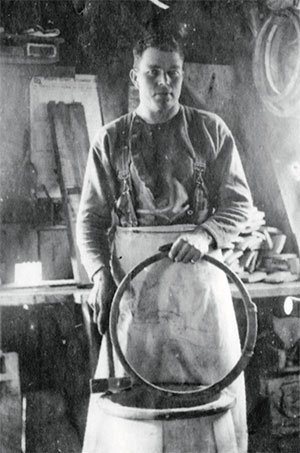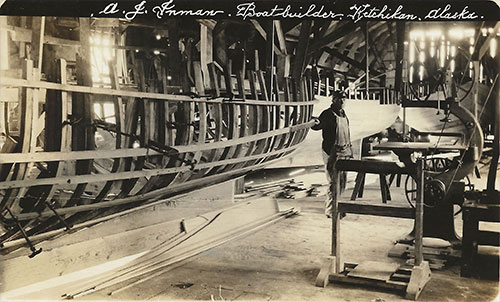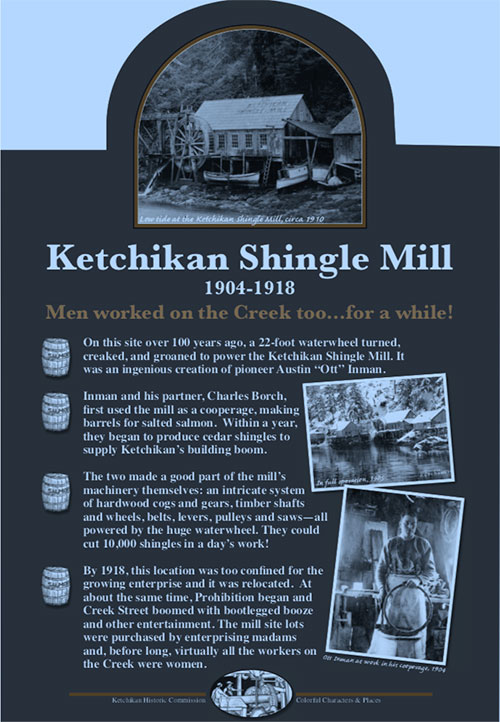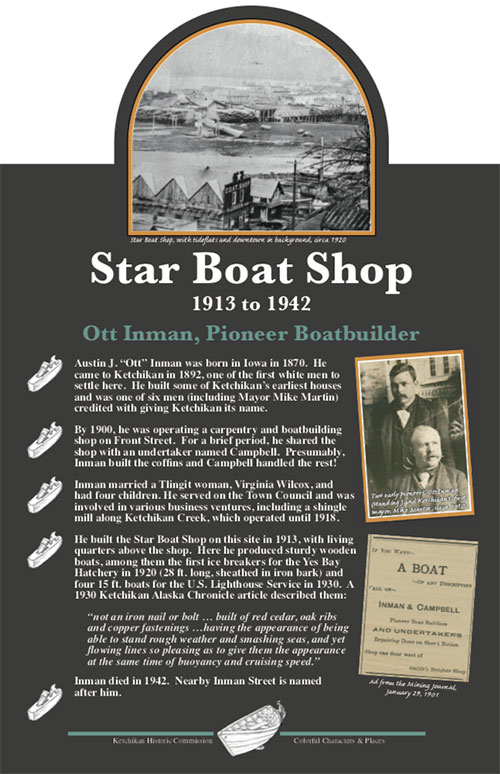Ott Inman: One of the builders of KetchikanBoat builder, sawmiller, cooper, undertakerBy DAVE KIFFER April 21, 2020
Inman first came to Ketchikan in 1891 and became a boat builder, a sawmill operator, even an undertaker, in the tiny village along Tongass Narrows. Inman was born in Iowa on January 10, 1870, according to his obituary in the April 15, 1942 Ketchikan Chronicle. When he was six, he moved with his family to Puget Sound, eventually settling in Olympia. He later moved to Seattle, hoping to start his own boat shop. "In Seattle, he heard about Alaska and its wealth of fish and furs and although he doubted the stories, he became interested in the Territory," the obituary noted. "Later he met a group of men who were coming to Alaska in a 32-foot sailboat and decided to join them. It was the fall and the group of four intended to return to Seattle the following spring." It took three months for the sail boat to get to Ketchikan, according to the obituary. On Oct. 26, 1891, the sailboat reached Behm Canal. The crew maneuvered the craft through the canal and arrived in Loring, then a modesty-sized cannery town about 14 miles north of Tongass Narrows. They met Loring pioneer Dick Stack and he advised them to go to Ketchikan instead. "Previously, they had met Yes Bay Johnny, an Indian, when they camped at Yes Bay," the obituary noted. "He informed them they were trespassing on his hunting grounds, but they stayed there for three weeks." Compared to Loring which in those days had a large cannery, a salmon hatchery and a year-round population of 200. Ketchikan at the time was barely a blip with a population of 40 according to the 1890 Census. "There were only five buildings here when the quartet came to Ketchikan, Mr. Inman used to recall, including warehouses and homes," the obit continued. ""There were also smokehouses on the other side of the creek. The following spring, Mr. Inman built three shacks, one for himself and two for the other men. Mr. Inman also had a hand in the construction of the old house, behind the First National bank building, which was torn down recently (in 1942). " The obituary noted that that house had been owned by George Clark - who along with Mike Martin - is generally credited as one of the town founders. The Clark house - which housed Clark's wife and three children and two maids, the first white family in the area - was originally built near what the is the corner of Dock and Front streets. It was later moved to Dock and Main, behind the bank.
The obituary also attempted to clear up a little local lore. "Robert McCoombs is generally credited with being the first white baby born in Ketchikan, but Mr. Inman disputed this," according to the obituary. "The first white child born here was to Captain Charles Dyer and his wife, in a shack Mr. Inman built alongside what is now the Commercial Building (later the NBA and Wells Fargo building). Captain Dyer was a partner of Tom (Helm Bay) Johnson who is now living in the Ketchikan." The obituary also repeated the oft-told story of how Inman was involved in the "naming" of Ketchikan. "There was no name for Ketchikan at the time that Mr. Inman came here, but about a year later, an a convivial gathering, Mr, Inman, Mike Martin, George Clark and Julius Sternberg and a few others decided on Ketchikan - which in Indian means stinking waters," the obituary reported. "Mr, Inman recalled that the name was decided upon just after the spawning season, when the banks of Ketchikan Creek were littered with dead salmon." That naming "ceremony" would have been in 1892. In the 1890 US Census, the 40-person community was already referred to as "Kichkan." Finally, the obituary noted how Austin Inman came to be known as "Ott" Inman. "Mr. Inman explained his name of Ott, as he was called, by saying that in the early days men were known by just a one-syllable word. His first name was Austin, but Ott made a more suitable nickname, and he didn’t object." Inman almost immediately made friends in the local Native community. He also married a Tlingit woman, Virginia Wilcox and had four children. “He met Chief Johnson and they became very good friends,” Ott's granddaughter Delma Inman told the Ketchikan Story Project in 2017. “Chief Johnson and my grandfather, they were kind people, probably why they both got along so well.” “My grandfather always wanted to be a boat builder,” she said in 2017. “He had a steam box and he put lumber in that steam box and when it was soft enough to bend he’d put it on the shell of the boat and then I used to help him caulk the seams. When he was done. I’d get to burn the Star on the back of the boat. It was the Star Boat Shop.” By 1900, when Ketchikan incorporated and became one of the first cities in the Territory of Alaska, Inman had already been an active boat building in the Thomas Basin area for several years. His "Star Boat Works" shows up in several early photos of the area. The boat house was located not far from where the current Salvation Army is Thomas Basin.
Advertisements for the boat shop appeared in Ketchikan Mining Journal in January 1901, also referring to it as the Inman and Campbell boat shops. The company also offered "undertaker" services as well. But by March of that year, Campbell was no longer mentioned and neither was "undertaking." Over the next two years, the Mining Journal noted that the boat shop launched several boats for several familiar local families including the Stedmans and the Burkhardts. Inman also began a lumber mill together with the boatyard. Inman would operate that Downtown lumber mill until 1919 when he would sell it and the new owner would move it to Charcoal Point (near the current Marine Highway Terminal) where it would operate until a fire shut it down in the 1950s. A specific ad in the November 2, 1901 Mining Journal notes "If you want a boat of any description. Call on O..H.. Inman. Pioneer Boat Builder. Repairing done on short notice. Lumber Yard. Shop one door west of Smith's Butcher Shop." In 1903, the Mining Journal noted that Inman moved his boat works across Ketchikan Creek to the "Lathrop property" just east of St. Agnes Mission. Unlike his good friend Martin, Inman showed ,little interest in local politics(Martin was the first Mayor) but Inman was also "elected" Assistant Foreman of the Ketchikan Fire Department in June of 1901 and Street Commissioner in September of 1902. Inman's brother Harry was on the first town council in 1900. In 1904 Ott Inman began one of his most prominent non-boat building efforts, a barrel and shingle factory on Creek Street. He would also build a long water flume to carry water to power the wheel from the Ketchikan Creek falls. The factory and its prominent water wheel was located adjacent to where the Eagles Lodge is now located on Creek Street. A 1921 document In the Ketchikan Recording Office described the operation. "A. J. Inman & Charles H. Borch claimed the use of water from Ketchikan Creek that was unused by Citizens Light Power, and Water Co. to be taken opposite flume of that company. Right away for a flume 12 inches deep and 24 inches wide running from said point to Cooper shop to be erected on banks of creek above the Ketchikan bridge. Said water to be used to run a water wheel to operate a cooper and barrel manufactory on the site." The Shingle plant itself was described as "24’ by 48’ main building, water wheel, shafting, wheels, saws, pulleys, bits, etc. Water rights plus flume 900 feet long, 20 inches deep and estimated 24 inches wide." An article in the June 24, 1905 edition of the Mining Journal noted the shingle mill began operating earlier that week. "Inman & Borch have completed their shingle mill at the mouth of Ketchikan Creek and began sawing shingles Thursday afternoon. The gentlemen composing this firm are experienced coopers, boatbuilders and carpenters, and have made most of the machinery in the mill themselves. Water power is used, a flume from the falls giving them all the power necessary. A 22-ft. wheel receives the water and shafts and belts transmit the power to the different saws. Inside are two 10-ft. wheels used to increase the speed of the transmitted power. A fine Perkins shingle saw has been installed, which with a a(sic) cut-off saw and a rip saw finish the shingle for the weaver. A force of three men is employed at present and about 10,000 shingles per day are turned out. Cedar timber is used, that from this island being especially excellent for this purpose – much better, experts say, than that growing on the Sound in Washington.
"A ood (sic) local market is assured for the shingles at good prices, and as the shingles they turn out are the highest grade a demand for them will come from all over the district." The next year, the shingle mill made the news again. "Fire- an alarm of fire last Sunday night, at about 9 o’clock, called the fire brigade to the east side of Ketchikan Creek, not far from Inman’s cooper shop, where fire had been discovered in the roof of a house occupied by one of the scarlet women of the town. ," the Mining Journal reported in March of 1905. "The flames were readily extinguished, but not without first tearing away a part of the roof and doing considerable damage to the building." Ads in the "Morning Mail" and the "Ketchikan Miner" in 1912 and 1913 indicated the shingle mill was still running in those year, But by 1919, Inman had sold the business and it would also move to Charcoal Point. By 1920, Inman had clearly turned his attention back to boat building. "The first ice breakers constructed in Ketchikan for the government to be launched from the Star Boat Shop. I. J. Inman, Proprietor," the Ketchikan Alaska Chronicle reported on Sept. 8, 1920. "They will be used at Yes Bay hatchery. They are constructed out of Fir and sheathed with Iron Bark. 28 feet long, 7-foot beam, and 3-foot deep." Inman got another lucrative government contract a decade later. "It has been demonstrated on more than one occasion that in Ketchikan are boat builders of rare skill in any line," the Chronicle reported on April 28, 1930. "Another example of this fact may be seen in four boats, each 15 feet long, which are being built for the United States lighthouse service by Ott Inman in his shop on lower Stedman street. He is just finishing two of the four. The model and plans are according to those furnished by the lighthouse department. There is not an iron nail or bolt in the boats. They are built of red cedar, oak ribs and copper fastenings. Oak is used for the bow and stern strengthenings. The boats are solid, having the appearance of being able to stand rough weather and smashing seas, and yet the flowing lines are so pleasing as to give them the appearance at the same time of buoyancy and cruising speed. Inman died at the Ketchikan Hospital on April 14, 1942. He was 72. Inman Street, above Thomas Basin, bears his name.
On the Web:
Contact Dave at dave@sitnews.us Dave Kiffer ©2020 Publication fee required. © Representations of fact and opinions in comments posted are solely those of the individual posters and do not represent the opinions of Sitnews.
|
||||||




